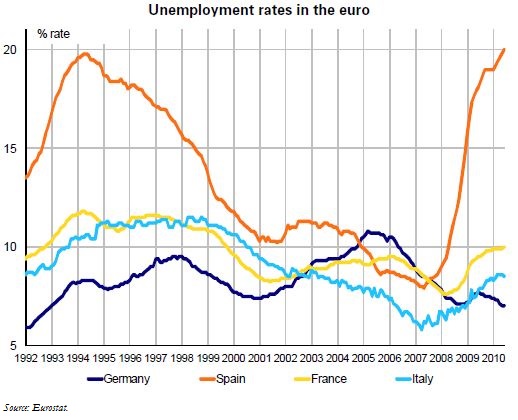Trésor-Economics No. 79 - What explains the resilience of employment in Germany?
Germany's unemployment rate hardly budged during the crisis: it was 7.3% in 2008 and 7.5% in 2009. This contrasts sharply with what happened in the other large countries of the euro zone - increases from 11.4% to 18.0% in Spain, from 7.8% to 9.4% in France, from 6.8% to 7.8% in Italy - and it occurred even though output in Germany declined by far more than the euro zone average. Three factors shed light on the remarkable resilience of the German labour market. Firstly, the labour market adjusted to the crisis essentially through a decline in hours worked per head (down 2.8% in 2009 compared with 2008). Employment remained virtually stable over the period. Secondly, in spite of this decline in hours worked, stability in employment was maintained at a cost to hourly productivity, which declined sharply during the crisis (down 2.2% in 2009). Lastly, a change in the definition of unemployment at the beginning of 2009 statistically reduced the measured unemployment rate by approximately 0.6 point during the first half of 2010.
The fact that large numbers of employees were kept in jobs during the downturn is the cyclical result of the structural employment policies put in place since 2003. These policies aim to increase the labour force participation rate and drive up long-term employment. The main motivation behind policies of this kind, and behind companies' willingness to maintain employment during the crisis, is surely related to the worrisome demographic situation in Germany. The country's working-age population has been shrinking: it fell by 2.6% between 1998 and 2009. Given the current low birth rate, the declining trend is set to accelerate over the next ten years as the baby-boomers retire.
Employers' fear of finding themselves short of skilled labour when growth resumes thus appears to outweigh their concern about a temporary loss of earnings due to reduced hourly productivity. The strong financial positions of German companies would also have made it much easier for them to be flexible in their handling of the crisis.
The "Hartz" reforms, implemented gradually between 2003 and 2005, had already borne fruit before the crisis struck. The gist of these reforms was to increase labour market flexibility and provide incentives for those in the non-working fringe of the population to join or rejoin the labour force. The success of these reforms is reflected in the 1.8% growth rate of the labour force between 2003 and 2008. Driving this growth was the rise in the participation rate from 77.2 to 79.6, which more than offset the 1.3% decline in the working-age population between 2003 and 2008.
During the crisis, these long-term policies were accompanied by short-term support policies intended to buttress companies' willingness to keep their employees in jobs. The partial unemployment system was extended, thereby rounding out a set of mechanisms that companies could use to reduce hours worked per head.
